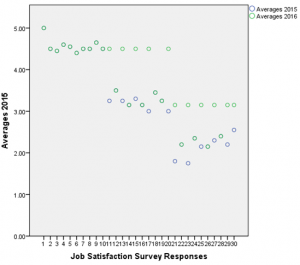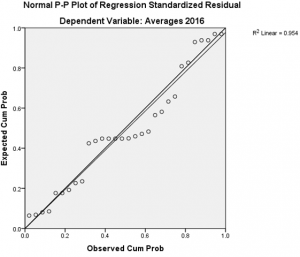Figure 1.2: Scatter plot
Linear Regression:
Research Question:
Does average job satisfaction level of the year 2015 is a predictor of average job satisfaction level of the year 2016?
Null Hypothesis: Average job satisfaction level of the year 2015 is not a predictor of average job satisfaction level of the year 2016.
Alternate Hypothesis: Average job satisfaction level of the year 2015 is a predictor of average job satisfaction level of the year 2016.
Regression Equation:
Averages 2016 = 1.449 + 0.693 (Averages 2015)
On the basis of p value < 0.001 at 95% confidence level, there has been found the strong statistically significant evidences to reject null hypothesis that states average job satisfaction level of the year 2015 is not a predictor of average job satisfaction level of the year 2016. By accepting the alternative hypothesis that the average job satisfaction level of the year 2015 is a predictor of average job satisfaction level of the year 2016, it has been found that R square is 0.653 that indicates 65.3% data variability around its mean. Coefficient of independent variable 0.693 predict that when a year increases, job satisfaction level increases by 0.693 points while R square shows the accuracy of this prediction which is 65.3%.
Table 1.4: Linear Regression
| Model Summary | ||||
| Model | R | R Square | Adjusted R Square | Std. Error of the Estimate |
| 1 | .808a | .653 | .640 | .51926 |
| a. Predictors: (Constant), Averages 2015 | ||||
| b. Dependent Variable: Averages 2016 | ||||
| ANOVA | ||||||
| Model | Sum of Squares | df | Mean Square | F | Sig. | |
| 1 | Regression | 14.187 | 1 | 14.187 | 52.618 | .000 b |
| Residual | 7.550 | 28 | .270 | |||
| Total | 21.737 | 29 | ||||
| a. Dependent Variable: Averages 2016 | ||||||
| b. Predictors: (Constant), Averages 2015 | ||||||
| Coefficients | ||||||||
| Model | Unstandardized Coefficients | Standardized Coefficients | t | Sig. | 95.0% Confidence Interval for B | |||
| B | Std. Error | Beta | Lower Bound | Upper Bound | ||||
| 1 | (Constant) | 1.449 | .332 | 4.368 | .000 | .769 | 2.128 | |
| Averages 2015 | .693 | .096 | .808 | 7.254 | .000 | .497 | .889 | |
| a. Dependent Variable: Averages 2016 | ||||||||
Figure 1.3: Normal P-P Plot
One Way Anova:
Research Question:
Is there a significant mean value differences among all three groups in the years 2015 and 2016?
Null Hypothesis: A mean value is same among all three groups in the years 2015 and 2016.
Alternate Hypothesis:A mean value is not same among all three groups in the year 2015 and 2016.
On the basis of p value < 0.001 at 95% confidence level, there has been found the strong statistically significant evidences to reject null hypothesis that states a mean value is same among all three groups in the years 2015 and 2016. By accepting the alternative hypothesis that a mean value is not same among all three groups in the year 2015 and 2016, it has been found that a mean value for three groups in the year 2015 are 4.565, 3.23 and 2.185 respectively while a mean value for three groups in the year 2016 are 4.565, 3.9 and 2.8 respectively.
Table 1.5: One Way Anova
| Descriptive | |||||||||
| N | Mean | Std. Deviation | Std. Error | 95% Confidence Interval for Mean | Minimum | Maximum | |||
| Lower Bound | Upper Bound | ||||||||
| Averages 2015 | 1 | 10 | 4.5650 | .16841 | .05326 | 4.4445 | 4.6855 | 4.40 | 5.00 |
| 2 | 10 | 3.2300 | .16533 | .05228 | 3.1117 | 3.3483 | 3.00 | 3.50 | |
| 3 | 10 | 2.1850 | .24950 | .07890 | 2.0065 | 2.3635 | 1.75 | 2.55 | |
| Total | 30 | 3.3267 | 1.00899 | .18422 | 2.9499 | 3.7034 | 1.75 | 5.00 | |
| Averages 2016 | 1 | 10 | 4.5650 | .16841 | .05326 | 4.4445 | 4.6855 | 4.40 | 5.00 |
| 2 | 10 | 3.9000 | .64205 | .20303 | 3.4407 | 4.3593 | 3.15 | 4.50 | |
| 3 | 10 | 2.8000 | .45704 | .14453 | 2.4731 | 3.1269 | 2.15 | 3.15 | |
| Total | 30 | 3.7550 | .86576 | .15807 | 3.4317 | 4.0783 | 2.15 | 5.00 | |
| ANOVA | ||||||
| Sum of Squares | df | Mean Square | F | Sig. | ||
| Averages 2015 | Between Groups | 28.462 | 2 | 14.231 | 361.978 | .000 |
| Within Groups | 1.061 | 27 | .039 | |||
| Total | 29.524 | 29 | ||||
| Averages 2016 | Between Groups | 15.892 | 2 | 7.946 | 36.702 | .000 |
| Within Groups | 5.845 | 27 | .216 | |||
| Total | 21.737 | 29 | ||||
Post Hoc (Tukey) Tests shows the multiple comparisons of all groups for both of the years and indicates that there is a significant mean differences among all groups at 0.05 significance level. By comparison of group means from 2015 to 2016, group 1 shows no difference in the mean from 2015 job satisfaction level to 2016 job satisfaction level while there has been found a difference between two years group means for group 2 and 3 as it can be seen in figure 1.4.
Table 1.6: Post Ho c Tests
| Dependent Variable | (I) Job Satisfaction Survey Responses | (J) Job Satisfaction Survey Responses | Mean Difference (I-J) | Std. Error | Sig. | 95% Confidence Interval | |
| Lower Bound | Upper Bound | ||||||
| Averages 2015 | 1 | 2 | 1.33500* | .08867 | .000 | 1.1151 | 1.5549 |
| 3 | 2.38000* | .08867 | .000 | 2.1601 | 2.5999 | ||
| 2 | 1 | -1.33500* | .08867 | .000 | -1.5549 | -1.1151 | |
| 3 | 1.04500* | .08867 | .000 | .8251 | 1.2649 | ||
| 3 | 1 | -2.38000* | .08867 | .000 | -2.5999 | -2.1601 | |
| 2 | -1.04500* | .08867 | .000 | -1.2649 | -.8251 | ||
| Averages 2016 | 1 | 2 | .66500* | .20808 | .010 | .1491 | 1.1809 |
| 3 | 1.76500* | .20808 | .000 | 1.2491 | 2.2809 | ||
| 2 | 1 | -.66500* | .20808 | .010 | -1.1809 | -.1491 | |
| 3 | 1.10000* | .20808 | .000 | .5841 | 1.6159 | ||
| 3 | 1 | -1.76500* | .20808 | .000 | -2.2809 | -1.2491 | |
| 2 | -1.10000* | .20808 | .000 | -1.6159 | -.5841 | ||
| *. The mean difference is significant at the 0.05 level. | |||||||
Figure 1.4: Bar Chart
This is just a sample partical work. Please place the order on the website to get your own originally done case solution.













